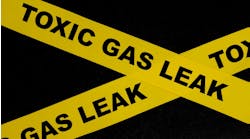Effectively Manage Large-Scale Process Hazard Assessments
No official or regulatory definition exists for large-, medium- or small-scale process hazard assessments (PHA). You can use a variety of factors such as the number of nodes, their complexity, the amount of people involved, or the length of time required for a PHA to characterize its size. Larger projects invariably lead to larger PHAs. After all, such projects typically entail considerably higher levels of risk than their smaller counterparts.
As the size of a PHA increases, the chances for confusion, delay or omission of critical safety tasks grow exponentially. Inadvertently omitting crucial tasks leaves the project vulnerable to safety mishaps, liability and potential business losses. Although techniques for conducting PHAs are essentially the same for any size effort, managing PHAs for large projects requires emphasis on numerous issues that may not exist or be trivial for small projects. This article looks at strategic considerations in managing large-scale PHAs.
The Big Picture
For any PHA, irrespective of size, key considerations include:
• identifying as many process hazards as possible in a reasonable time;
• promptly putting systems in place to address findings from the PHA;
• reducing risk to an acceptable level and maintaining that reduction for the lifetime of the project (i.e., the safety lifecycle);
• effectively transmitting vital safety information to the project sponsors;
• properly allocating the budget and achieving cost-effectiveness; and
• maintaining confidentiality and security of data and documents.
The following strategic issues also merit consideration:
• project sponsors and their safety practices;
• PHA infrastructure;
• PHA software;
• document management; and
• safety lifecycle management.
Project Sponsors
Very frequently, large projects involve multiple sponsors — with these organizations often based in different geographic regions. Each sponsor invariably has its own unique safety philosophies, safety assessment procedures and risk tolerance criteria. Unsurprisingly, their definition of risks could differ substantially. The lack of a common understanding of project scope and PHA expectations increases the chance of dissatisfied or even irate sponsors — and may render the PHA useless. It’s not always easy to get sponsors to agree. Diplomacy is a valuable trait for a PHA manager.
Here are some crucial points to keep in mind:
• Focus on getting a general agreement on the scope of the PHA.
• Develop consensus on safety philosophy as well as a common safety philosophy and PHA assessment procedures for the project. This often is covered in a strategy document called PHA Terms of Reference.
• Establish common risk assessment criteria and risk tolerance definitions.
• Discuss PHA schedules, web access by remote participants, and the number of participants from specific sponsors. If the sponsors are in different regions, work out a PHA meeting schedule that maximizes participation.
• Agree upon PHA methodology and software (e.g., hazard and operability studies (HAZOPs), layers of protection analyses (LOPAs), safety integrity level (SIL) assessments, or other equivalent techniques).
• Maintain confidentiality of sponsors’ documents.
The above list isn’t exhaustive; others points also may be crucial and demand attention.
Early stages of PHAs involve intense and extended discussions. Some sponsors may feel passionately about their safety systems and PHA methodologies. For a PHA manager, this is an opportune time to establish effective working relationships among sponsors. The aim is to enable the diverse group of sponsors to work cohesively.
PHA Infrastructure
This includes documents and data relevant to a PHA as well as video conferencing systems. Obviously, key documents such as process and instrumentation drawings (P&IDs), process flow diagrams, heat and material balances, cause and effect diagrams, equipment data sheets, drawings, and applicable regional regulations are vital; they should be instantly available for the PHA. In addition, consider the following issues:
• When a PHA occurs during an ongoing project, keeping track of documents can be difficult. Isolate and “freeze” all relevant P&IDs. As the project progresses, record appropriate notes as a part of the document management task.
• Ensure the video conferencing system is compatible with the information technology (IT) systems of all sponsors. (This point may seem obvious but it’s easy to miss.)
• Include different units of measurement in documents when this would help sponsors. For example, report flow rates in gal/min and m3/hr, or other similar units.
• Several days prior to the start of the PHA, conduct a mock run to ensure all video conferencing systems are working seamlessly. Keep IT help on standby to minimize painful delays in the PHA.
• Transmit electronic copies of relevant documents to all participants a week or so in advance of the PHA.
• One key issue that comes up during many PHAs is: “What is the quantity of a release or spill?” This quantity forms a basis for assigning risk level. So, consider developing equations in spreadsheets or lookup tables that enable quickly estimating release quantity or rate with a reasonable level of confidence.
• PHAs often use a risk matrix. Many such matrices define risks rather broadly or inadequately, meaning estimates can differ widely. Risk perception by different team members ideally should match reasonably closely — and certainly shouldn’t vary by a wide margin. To foster team members coming up with relatively similar estimates of risk levels, define consequence and likelihood of events to an adequate degree of detail.
PHA Software
Large-scale PHAs involve massive amounts of data. Obviously, you can’t afford to use software that crashes, responds painfully slowly, or is hard to configure. Consider both near-term and long-term factors. Near-term factors include the suitability of the user interface: ease of use; entering and editing; and importing/exporting data (e.g., search, sort, save, delete, macro functions or special short-cut commands, templates and data transfer). It should be relatively easy to formulate nodes, navigate between nodes, embed the risk matrix, track recommendations, and generate reports and PHA statistics. Some sponsors may not have the proposed software package. So, it’s important to ensure they have easy access to the PHA files. The software should generate Microsoft Office files without requiring onerous steps.
The use of a mature software package lessens the chance of disruption. However, PHA software continually is improving and your system can’t afford to be static. Verify you are using the latest version of software. If you plan to use relatively new software, conduct several mock runs to ensure the software package will function efficiently. Stay away from software in its nascent stage of development. Such software could cause painful disruptions and costly delays in the conduct of a PHA.
In the long-run, you want to make certain the PHA software remains reliable and efficient. So, assess the following:
• Vendor support. Competent technical support from the vendor is vital for ensuring that relevant changes in data, data structures or formats can be made in a timely manner.
• Software updates. Ideally, the upgrades should be seamless or near-seamless.
• Longevity of company and software. Look for a stable company that upgrades PHA software in well-organized steps and offers updates that are easy to install. Unfortunately, determining this is easier said than done. Acquisitions and divestitures will continue to impact the roster of vendors.
• Continual improvement. Cloud-based systems are gaining acceptance and popularity. Regardless of where it resides, PHA software should be capable of connecting with other programs for health, safety, security and quality management.
• Cybersecurity. Although the number of cyber intrusions on industrial control and safety systems is on the rise, PHA data have not yet been affected. However, appropriate safeguards against cyber intrusions merit attention. Close working relationships between IT and safety/security groups will be vital.
• Effective tracking. It’s essential to know the current status of corrective actions on recommendations, risk status and re-validations of PHAs.
• Data analytics. There’s growing realization that PHAs and safety functions could offer valuable insights for improving safety if data are analyzed carefully.
• Easy access to data. Keep track of the compatibility of sponsors’ database management systems with the PHA software, and make provisions so sponsors readily and quickly can access relevant documents in usable form.
Document Management
One major issue for multisponsor PHAs is hassle-free access to data. You must iron out access rights and procedures during the early stages of a project. Document management should provide accurate and updated data or files quickly. Generally, PHA managers will use the existing document system unless it’s grossly outdated. Intense involvement by document management professionals is crucial. Broad items to consider include:
• Document integrity and security. You must define different levels of access.
• Data inputs. The document system should accept data in numerous forms, e.g., e-mails, mobile texts, scanned documents, manual entry and bulk loads of data.
• Ease of use. Ensure all users have easy access to review and receive printouts of data and get update notifications.
• Collaboration. The system must provide provisions for document routing and for team members to collaborate.
• Alternative access. Make certain users still can access critical data if the primary means (such as via the cloud) causes problems.
• Support. Competent document management personnel should be available to users quickly.
• Streamlined operation. Don’t create document bureaucracy. Team members must have fast access to vital information. Remember, the focus is on risk reduction and safety!
Safety Lifecycle Management
Risk reduction isn’t a one-time event; it continues until the end of a project. Systems must be in place to implement relevant changes (management of change), document them and update records. The safety lifecycle is an integral part of IEC 61511/ISA 84 and its numerous revisions.
To sum up, large projects generally entail larger risk than that of their smaller counterparts. Strategic management requires some important traits from a PHA manager including diplomacy, patience and working knowledge or familiarity with the PHA software, database management and document management systems.
GC SHAH, PE, is a senior HSE advisor at Wood, Houston. Email him at [email protected].

